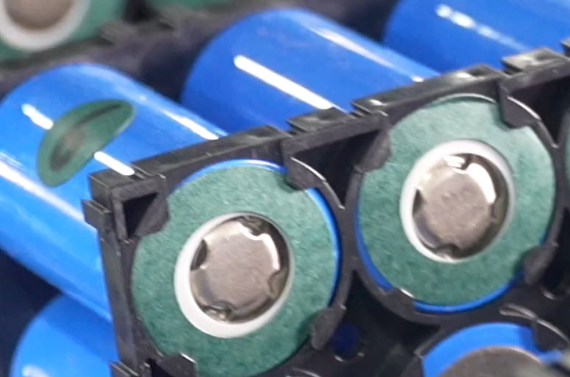lithium-ion 14500 cylindrical rechargeable battery, featuring 3.7 volts, has a diameter of 14mm and a height of 50mm, which is similar in size to a common $s5 battery. This battery typically has superior discharge performance and moderate nominal capacity to meet the needs of a wide range of devices. It is often used in consumer electronics products, such as wireless stereos, to provide a stable and long-lasting power supply to ensure that users can enjoy music without power problems. It is also widely used in devices such as motorized toys and digital cameras. These devices often require batteries with high energy density and good discharge performance, which the 14500 battery is able to fulfill. Overall, the Li-ion 14500 cylindrical rechargeable battery 3.7 volts has a wide range of applications in the field of consumer electronics with its moderate size, superior discharge performance and stable voltage output. Whether it is music entertainment, children's toys or photographic equipment, it can bring convenience and fun to our lives.
Lithium-ion 14500 cylindrical rechargeable batteries have been widely used in many electronic devices due to their convenient size, stable discharge characteristics and relatively high energy density. In this article, we will introduce the characteristics of Li-ion 14500 batteries, the use of occasions and precautions, to help you fully understand this common power solution.
The model name of the Li-ion 14500 battery comes from its physical dimensions, where "14" indicates a diameter of 14 millimeters and "500" indicates a length of 50.0 millimeters. This size is similar to that of a conventional AA dry cell battery, but the 3.7 volt Li-Ion 14500 battery is far superior in performance to alkaline or nickel-metal hydride batteries of the same size. Today, this battery is used in a wide range of portable electronics.
Lithium-ion 14500 batteries generally use lithium cobaltate (LiCoO2), lithium iron phosphorus (LiFePO4) and other cathode materials, the negative electrode material using graphite, the electrolyte is mostly organic electrolyte. The positive and negative electrodes are separated by a diaphragm, which is usually made of polypropylene (PP) or polyethylene (PE). These materials are used in conjunction with advanced battery design and manufacturing processes to ensure the stability and safety of battery performance.
Lithium-ion 14500 batteries typically have a voltage of 3.7 volts and a charge voltage of approximately 4.2 volts. The battery has a high energy density, provides a long service life, and has good high and low temperature operating performance. Compared to other types of rechargeable batteries, lithium-ion batteries have advantages in terms of weight, size, and range.

The main uses of lithium-ion 14500 batteries include:
Portable lighting devices: such as strong flashlights, headlights, Bicycle lights, etc. These devices need to be compact and lightweight as well as have a long range.
E-cigarettes: Lithium-ion 14500 batteries have become the standard power solution for many e-cigarettes products, thanks to their stabilized output effect and long cycle life.
Wireless communication devices: such as Bluetooth headsets, wireless mice, and other lightweight electronic products, they require compact and long continuous operating time batteries.
Outdoor sports equipment: handheld GPS devices, electronic compasses, sports cameras and other outdoor equipment are also commonly used 14500 batteries to meet their needs for portability and endurance.
Medical equipment: some portable medical monitoring devices and treatment equipment will also use 14500 batteries, it is important that these devices need to ensure the reliability and stability of the battery.
And, as technology advances and market demand increases, lithium-ion 14500 batteries are also likely to be used in smart wearables, small drones, and some specialized industrial instrumentation.
While Li-ion 14500 cylindrical rechargeable batteries are a very stable and safe storage device for electrical energy, the following points need to be noted when using and maintaining them:
Avoiding overcharging and overdischarging: overcharging will cause the internal pressure of the battery to rise, which may cause safety problems; over-discharge will leave the battery in an over-discharged state, affecting battery life.
Use a suitable charger: You should use a charger specifically designed for Li-ion 14500 batteries to ensure safe charging and improve battery life.
Storage environment: The battery should be stored in a dry and cool environment when not in use, avoiding high temperature, humidity or direct sunlight.
Avoid Physical Damage: Do not subject the battery to severe impact or pressure, as this may cause damage to the internal structure of the battery.
Periodic inspection: Regularly check the appearance of the battery for abnormalities such as expansion, leakage, overheating, etc., and replace damaged or degraded batteries in a timely manner.
Following these basic rules of use and maintenance can effectively extend the service life of lithium-ion 14500 batteries and protect the normal operation of electronic equipment.
In summary, lithium-ion 14500 cylindrical rechargeable batteries 3.7 volts are widely used in many daily portable electronic devices due to their efficient energy density, stable discharge characteristics and reliable safety performance. With reasonable use and maintenance, this battery can provide users with long and stable power support.